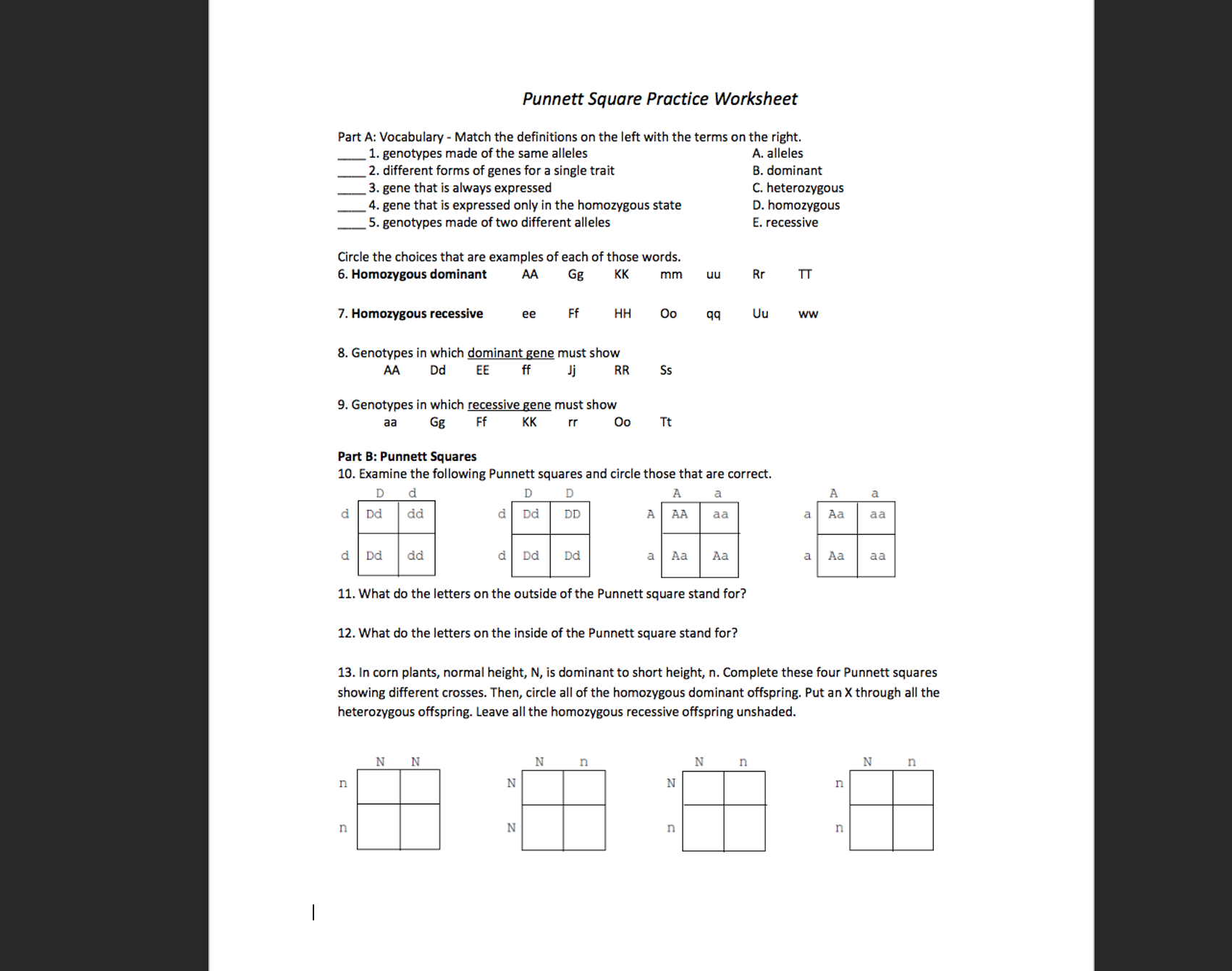Have you ever wondered why your eyes are blue while your sibling’s are brown? Or how your family’s genetic traits are passed down through generations? The answer lies in the fascinating world of genetics, and one of the key tools used to understand it is the Punnett square. This simple yet powerful worksheet helps us predict the inheritance of traits in offspring, serving as a roadmap for understanding how genes are combined and expressed.

Image: myans.bhantedhammika.net
Imagine a detective sleuthing through clues to unveil a mystery. The Punnett square acts as the detective’s magnifying glass, revealing the patterns of inheritance hidden within our DNA. This is where the Punnett square worksheet becomes your indispensable guide. It assists you in visualizing the various combinations of alleles (alternative forms of genes) that a parent can pass on to their offspring and the resulting genotypes and phenotypes (actual physical characteristics). Ready to join the genetic detective team? Let’s dive into the world of Punnett squares!
The Power of Prediction: Decoding the Punnett Square
At its heart, the Punnett square is a simple grid that helps us predict the probability of different genotypes and phenotypes in offspring based on the genotypes of their parents. Each parent contributes one allele for a particular trait, and the Punnett square shows all the possible combinations of these alleles in their offspring. Understanding the basics of the Punnett square is like learning the alphabet of genetics, allowing us to decipher the complex language of heredity.
Understanding the Basics: A Genetic Journey
Imagine a simple trait like flower color, where purple is dominant (represented by “P”) and white is recessive (represented by “p”). Each parent carries a pair of alleles for this trait. Let’s say one parent is homozygous dominant (PP), meaning they have two dominant alleles for purple flowers. The other parent is heterozygous (Pp), carrying one dominant (P) and one recessive (p) allele.
To create a Punnett square, we draw a simple grid with four squares. One parent’s alleles are listed across the top of the grid, while the other parent’s alleles are listed along the side. We then combine the alleles from each parent and place them in the corresponding squares. For example, the top left square would represent the combination of “P” from the mother with “P” from the father, resulting in a genotype of PP.
Visualizing the Probabilities: Unveiling the Genetic Possibilities
By analyzing the Punnett square, we can determine the probability of different genotypes and phenotypes in the offspring. In our example, there is a possibility of getting PP, Pp, or pp genotypes. Since purple is dominant, the offspring with PP or Pp genotypes will have purple flowers, while only those with pp will have white flowers.

Image: printablelibsteffen.z19.web.core.windows.net
Expanding Horizons: Exploring More Complex Traits
The Punnett square’s application extends beyond single traits. It can handle more complex scenarios involving multiple genes and traits. For example, we can use a Punnett square to analyze the inheritance of two traits simultaneously, such as flower color and plant height. This involves creating a larger Punnett square, with each dimension representing a different trait, and considering all the possible combinations of alleles for both traits.
Unveiling Human Genetics: A Powerful Tool for Medical Advancements
Punnett squares are widely used in medicine, research, and agriculture. In medicine, they help doctors understand the risk of certain genetic diseases being passed down to children. For example, cystic fibrosis is a genetic disorder caused by a recessive allele. Parents with a family history of cystic fibrosis can use a Punnett square to assess their chances of having a child with the disorder. This knowledge empowers families to make informed decisions about their reproductive choices and consider genetic testing, if needed.
The Role of Punnett Squares in Genetic Research
The Punnett square is an invaluable tool for researchers studying genetics. It provides a framework for understanding how genes segregate and recombine during meiosis, the process of cell division that generates gametes (sperm and eggs). This helps scientists identify genetic markers (specific DNA sequences) linked to specific traits and diseases. This knowledge can lead to the development of new genetic tests, gene therapies, and personalized treatments tailored to an individual’s genetic makeup.
Beyond the Classroom: Practical Applications in Agriculture
Even in agriculture, Punnett squares play a significant role in plant breeding. Breeders utilize this tool to select parent plants with desirable traits and predict the probability of producing offspring with the desired combinations. This is critical for developing crops with improved yields, resistance to pests and diseases, and enhanced nutritional content.
Mastering the Punnett Square: Tips for Success
Whether you’re a student grappling with genetics concepts or a curious individual exploring the wonders of inheritance, mastering the Punnett square can be a rewarding journey. Here’s a set of tips for maximizing your understanding:
Practice Makes Perfect: Dive into the World of Genetics
The key to success with Punnett squares is consistent practice. Start with simple examples involving one trait, then gradually move on to more complex scenarios. Utilize online resources, interactive simulations, and practice problems to solidify your understanding of the concepts.
Seek Guidance: Leverage Educational Resources
Don’t hesitate to seek guidance from teachers, professors, or online tutorials. There are numerous educational resources available, including videos, websites, and textbooks providing clear explanations and step-by-step instructions for mastering Punnett Squares.
Punnett Square Worksheet
The Punnett Square: A Glimpse into the World of Genetics
From understanding inherited traits to predicting genetic probabilities, the Punnett square serves as a powerful tool for exploring the complexities of genetics. By embracing this simple yet insightful tool, we unlock the mysteries of heredity, paving the way for informed decisions, advancements in medical science, and innovations in fields like agriculture. So, embark on your genetic journey, armed with the knowledge and power of the Punnett square! Continue to explore the world of genetics, and you’ll be surprised by the intricate connections and profound implications of inheritance in our lives.






